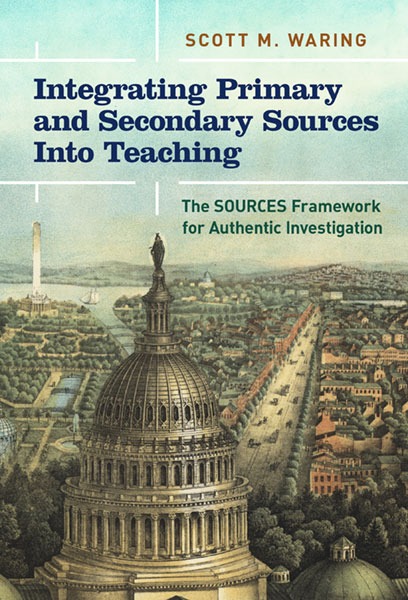Professors: Request an Exam Copy
Print copies available for US orders only. For orders outside the US, see our international distributors.
Publication Date: January 1, 2021
Pages: 192

Learn how to integrate and evaluate primary and secondary sources by using the SOURCES framework. SOURCES is an acronym for an approach that educators can use with student in all grades and content areas: Scrutinize the fundamental source, Organize thoughts, Understand the context, Read between the lines, Corroborate and refute, Establish a plausible narrative, and Summarize final thoughts. Waring outlines a clearly delineated, step-by-step process of how to progress through the seven stages of the framework and provides suggestions for seamlessly integrating emerging technologies into instruction. The text provides classroom-ready examples and explicit scaffolding, such as sources analysis sheets for various types of primary and secondary sources. Readers can use this resource to give students the skills and knowledge necessary to think critically and create evidence-based narratives, in a manner similar to professionals in the field. Integrating Primary and Secondary Sources Into Teaching will be of interest to social studies educators and curriculum coordinators, as well as those involved in curriculum design, planning, and technology integration across the content areas.
Book Features:
Scott M. Waring is a professor and the program coordinator for the Social Science Education Program at the University of Central Florida.
“This book is an essential read for anyone with a desire to take the important research findings about the benefits of primary source analysis and effectively integrate them into social studies education.”
—Teachers College Record
“Integrating Primary and Secondary Sources Into Teaching empowers teachers to enact dynamic pedagogies that ignite student curiosities and positions them for deep critical thinking through authentic investigation. Waring’s text is an inspiring guide bursting with practical, classroom-ready, primary-source-rich lessons that promote student inquiry while building the professional capacity of teachers. It’s exactly what teachers want.”
—Tina M. Ellsworth, National Council for the Social Studies Board of Directors Member and Assistant Professor at Northwest Missouri State University
“An engaging read that is bursting with practical, classroom-grounded guidance. Each chapter centers on primary sources and pushes authentic, classroom level inquiry. It’s the type of book an educator looking to dive deeper into authentic primary source inquiry needs!”
—Brian Furgione, Research Scientist at Newsela and former K-12 teacher, instructional coach, and assistant professor of education
Contents (Tentative)
Preface ix
1. The SOURCES Framework for Teaching With Primary and Secondary Sources: An Introduction 1
Steps to Preparing Students to Think Critically and Utilize Primary Sources 3
Critical Examination of Sources 10
Evaluation of Sources 16
Primary Source Sets 18
The SOURCES Framework for Teaching With Primary Sources 23
2. What Would Historians Write About Thomas Garber? An Application of a SOURCES Lesson 29
Scrutinizing the Fundamental Source(s) 29
Organizing Thoughts 31
Understanding the Context 34
Reading Between the Lines 35
Corroborating and Refuting 36
Establishing a Plausible Narrative 43
Summarizing Final Thoughts 44
Conclusion 44
3. Assessing General Washington’s Plan to Attack Princeton at the Beginning of 1777: An Application of the SOURCES Framework 47
Scrutinizing the Fundamental Source(s) and Organizing Thoughts 50
Organizing Thoughts and Understanding the Context 51
Reading Between the Lines 52
Corroborating and Refuting 53
Establishing a Plausible Narrative 59
Summarizing Final Thoughts 60
Conclusion 60
4. Building Capacity for Student Agency: Using Baseball-Related Primary Sources and the SOURCES Framework 63
Scrutinizing the Fundamental Source(s) 64
Organizing Thoughts 65
Understanding the Context 65
Reading Between the Lines 66
Corroborating and Refuting 67
Establishing a Plausible Narrative 71
Summarizing Final Thoughts 72
Conclusion 72
5. What Motivated the Wright Brothers?An Application of the SOURCES Framework 73
Scrutinizing the Fundamental Source(s) 73
Organizing Thoughts 77
Understanding the Context 77
Reading Between the Lines 78
Corroborating and Refuting 78
Establishing a Plausible Narrative 79
Summarizing Final Thoughts 80
Conclusion 80
6. Using Poetry to Build the Capacity to EmpathizeAn Application of the SOURCES Framework 83
Scrutinizing the Fundamental Source(s) 83
Organizing Thoughts 86
Understanding the Context 86
Reading Between the Lines 90
Corroborating and Refuting 91
Establishing a Plausible Narrative 93
Summarizing Final Thoughts 94
Conclusion 94
7. Teaching Controversial LiteratureAn Application of the SOURCES Framework 97
Scrutinizing the Fundamental Source(s) 100
Organizing Thoughts 101
Understanding the Context 102
Reading Between the Lines 103
Corroborating and Refuting 103
Establishing a Plausible Narrative 109
Summarizing Final Thoughts 109
Conclusion 110
8. An Examination of CiphersAn Application of the SOURCES Framework 111
Scrutinizing the Fundamental Source(s) 112
Organizing Thoughts 114
Understanding the Context 114
Reading Between the Lines 115
Corroborating and Refuting 116
Establishing a Plausible Narrative 118
Summarizing Final Thoughts 118
Conclusion 118
9. Are We Alone in the Universe?An Application of the SOURCES Framework 121
Scrutinizing the Fundamental Source(s) 122
Organizing Thoughts 123
Understanding the Context 123
Reading Between the Lines 125
Corroborating and Refuting 125
Establishing a Plausible Narrative 127
Summarizing Final Thoughts 127
Conclusion 128
10. Engaging Students With Emerging Technologies:Web 2.0 Tools for Each of the Stages of the SOURCES Framework 129
Using Multimedia-Based Discussion and Polling Tools to Facilitate Scrutinizing the Fundamental Source(s) 130
Using Collection, Categorization, Storage, and Annotation Tools to Facilitate Organizing Thoughts 133
Using Collaborative and Discussion Tools to Facilitate Understanding the Context 137
Using Scaffolding Tools to Facilitate Reading Between the Lines and Corroborating and Refuting 140
Developing and Publishing Tools to Facilitate Establishing a Plausible Narrative 145
Creating a Digital Portfolio to Facilitate Summarizing Final Thoughts 149
Conclusion 151
11. Additional Resources and Considerations 153
Implementing the SOURCES Framework 153
Primary Sources and Copyright 155
Primary Source Repositories and Resources 157
SOURCES Framework for Teaching With Primary and Secondary Sources 161
The Future, Possibilities, Potential Roadblocks, and Making the Most of the Inquiry Process 163
References 167
Index 173
About the Author 182
Professors: Request an Exam Copy
Print copies available for US orders only. For orders outside the US, see our international distributors.